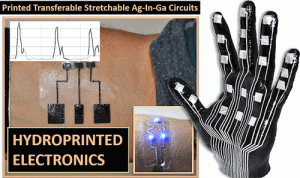Most of us don’t stop to think about it, but the skin on our body is pretty remarkable. The largest organ in the body can detect pressure, temperature changes, pain, and touch, all made possible thanks to the many nerves and receptors underneath our skin. With all that said, it’s easy to understand why it’s hard to duplicate this unique organ. But, according to ScienceDaily, researchers are working to do just that. Their goal is to reproduce and transfer these qualities into a manmade electronic skin technology that can be used in prosthetic devices, wearable health monitors, robotics, and virtual reality.
One of the major challenges in producing this technology comes in recreating skin’s stretchable, flexible, and thin nature. Researchers had to figure out how to transfer ultrathin electrical circuits onto complex 3D surfaces that can bend and stretch enough to allow this kind of movement.
To a certain degree, this has already been achieved in flexible “electronic tattoos” that serve this purpose, but production is typically slow, expensive, and requires clean-room fabrication methods such as photolithography. Researchers working on this project aimed to create an electronic skin aid technology that was faster, simpler, and inexpensive to develop.
In their new approach, the research team successfully patterned a circuit template onto a sheet of transfer “tattoo” paper, used an ordinary desktop laser printer, microchips, a conductive “glue,” and gallium-indium liquid metal alloy to create a flexible electronic skin product. They then transferred the electronic “tattoo” to various objects, reflecting how it could be used to control a robotic prosthetic arm, among a variety of human-machine interactions.
The researchers describe their work in a paper in the American Chemical Society journal.
Developing the sense of touch in electronic skin, is something scientists have been working on for quite some time. In 2017, engineers developed a flexible sensor “skin” that could stretch over any part of a robot’s body or prosthetic to accurately convey information about shear forces and vibration. Specifically useful in disabling roadside bombs.
Zhenan Bao, past ECS member and chemical engineer at Stanford University, is also among those working on improving the sense of touch in prosthetics.
Bao was a guest on NPR’s All Things Considered, where she described her work in developing a plastic artificial skin that can essentially do all the things organic skin can do, including sensing and self-healing.
Hear her full interview here:
(Get more on Bao: Read her past meeting abstracts in the ECS Digital Library for free.)


